The best lens for street photography in 2022: top 35mm prime lenses rated
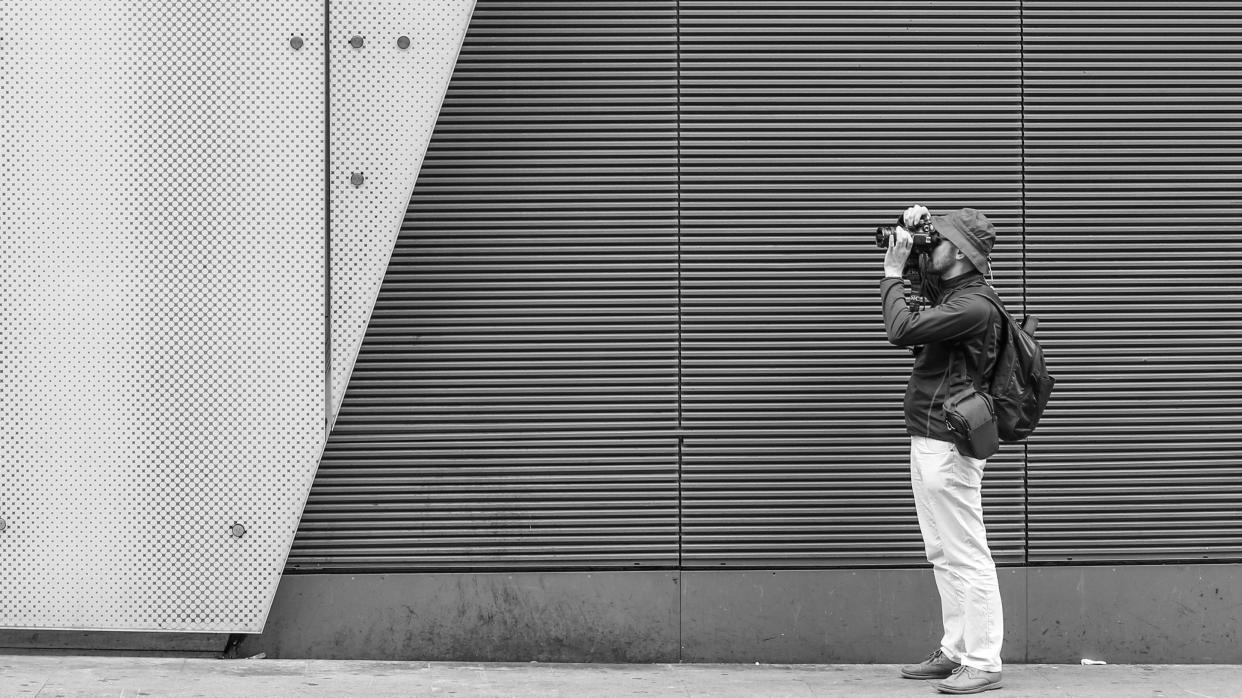
With the best lens for street photography, you shouldn't be thinking about your lens at all. This discipline is all about being reactive, immersing yourself in the moment, and as such, a good street photography lens only really requires two things.
More lens guides
Start here
? The best camera lenses to buy
What camera do you have?
? Best Canon lenses
? Best Fujifilm lenses
? Best Nikon lenses
? Best Olympus lenses
? Best Panasonic lenses
? Best Pentax lenses
? Best Sony lenses
One: it needs to be small. It should be unobtrusive, and avoid attracting attention the way a big zoom lens will. Also, since you're going to be carrying it around all day, your street lens should be nice and lightweight, since even with an extensively padded camera strap, if you carry a heavy lens around for more than a few hours, you'll feel it.
Two: it should sit within a relatively slim range of focal lengths. You want it to be wide, but not too wide, for the best street perspective. You want it at about 35mm, or close to, as this gives you a reasonably naturalistic perspective while still allowing you to fit plenty in the frame.
What's the answer? Generally, it's a 35mm prime lens. For decades, this has been accepted as the best lens for street photography and photojournalism, and this is one piece of received wisdom we're not going to argue with. If you're using full-frame then a 35mm lens is the ideal choice; for APS-C cameras, a lens of 24mm or so will give you an equivalent field of view.
Also, while purist street photographers insist that manual focus is the only way to go, in reality modern mirrorless cameras and DSLRs have highly sophisticated autofocus systems that you'd be silly not to take advantage of. As such, it makes sense to get a fast-focusing lens.
There is a lot of choice out there, so for this guide we've focused on Canon, Nikon and Sony cameras – even so, there are plenty of options. We've included options for full-frame and APS-C camera users, though if you're rocking a setup from the likes of Fujifilm, OM Systems (formerly Olympus) or Panasonic, you can head to our guide to the best pancake lenses where there are loads of great street options for all systems.
? Street photography tips you should know
Otherwise, let's dive into the best street photography lenses you can buy.
Best lens for street photography in 2022
Canon
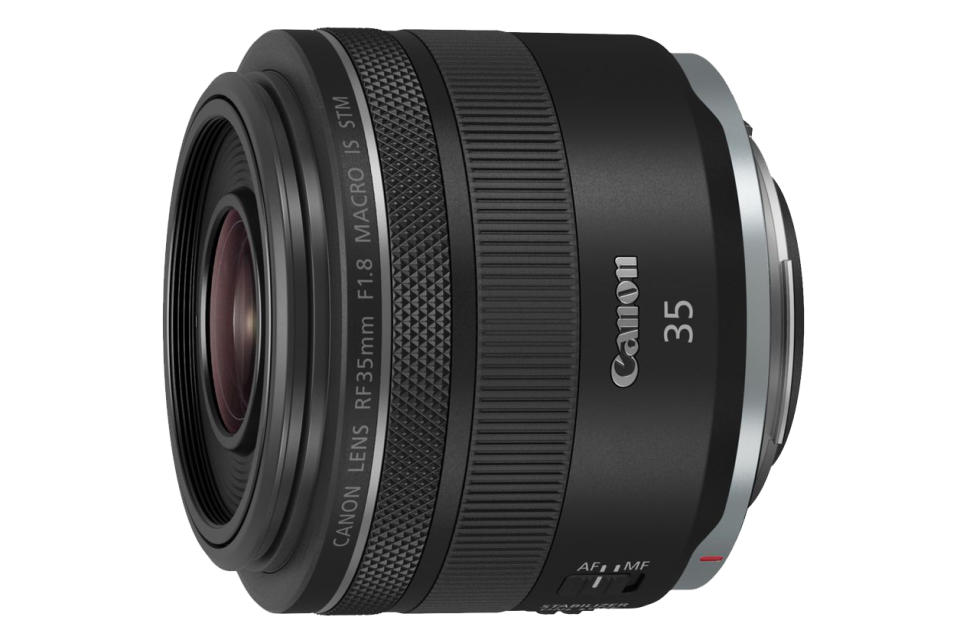
1. Canon RF 35mm f/1.8 IS Macro STM
Small in size, big on performance - a real treat for Canon RF-mount cameras
Mount: Canon RF | Elements/groups: 11/9 | Diaphragm blades: 9 | Autofocus: Stepping motor | Stabilizer: Yes, 5-stop, hybrid | Min focus distance: 0.17m | Max magnification: 0.5x | Filter thread: 52mm | Dimensions (WxL): 74x63mm | Weight: 305g
5-stop image stabilizer
Close focusing and macro ability
Stellar image quality
No DoF markings
This 35mm prime for EOS R and RP cameras is conveniently compact. Its stepping motor autofocus system means there’s no focus distance scale or depth of field markings, which are often preferred for ‘zone focusing’ in street photography. However, a distance scale, focus peaking and focus guide options are all available in the shooting displays of Canon’s R and RP bodies. Both autofocus and manual focusing work wonderfully well when using these cameras’ electronic viewfinders or vari-angle rear screens.
Further highlights include a very short minimum focus distance that enables 0.5x macro magnification and a class-leading 5-stop hybrid image stabilizer that’s great for both regular and close-up shooting. Typical of RF lenses, an extra bonus is the customisable ‘control ring’ for adjustment of parameters like aperture, shutter speed, ISO and exposure compensation.
Image quality is simply stellar. The lens is super-sharp across the whole image frame and the vignetting that’s slightly noticeable at f/1.8 mostly disappears when narrowing the aperture to f/2. The small amounts of lateral chromatic aberration and barrel distortion can be fully corrected in-camera, and the hybrid image stabilizer lives up to its 5-stop billing. The macro facility is mostly superfluous for street photography but can nevertheless come in handy.
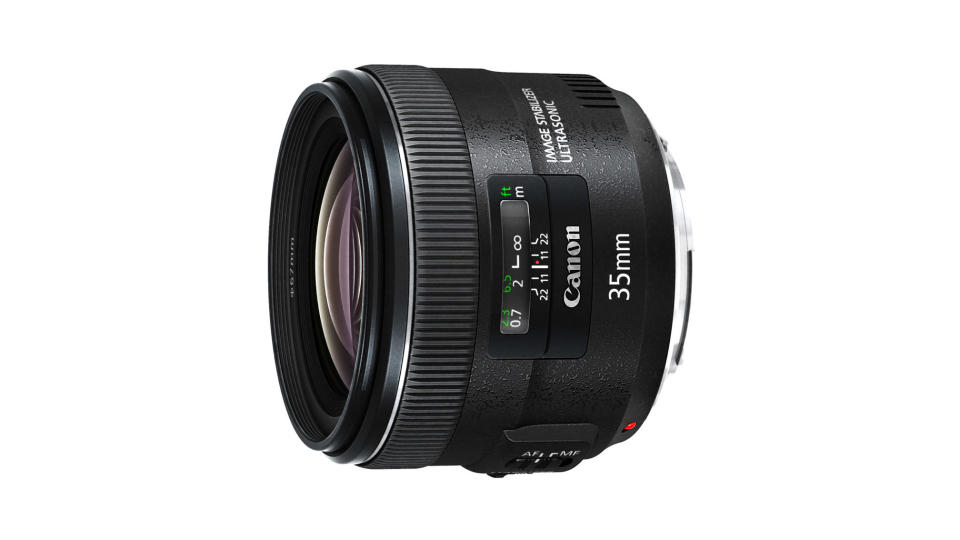
2. Canon EF 35mm f/2 IS USM
For street photography, this lens is practically perfect for full-frame Canon DSLRs
Mount: Canon EF | Elements/groups: 10/8 | Diaphragm blades: 8 | Autofocus: Ultrasonic (ring-type) | Stabilizer: 4-stop | Min focus distance: 0.24m | Max magnification: 0.24x | Filter thread: 67mm | Dimensions (WxL): 78x63mm | Weight: 335g
Excellent sharpness
Small and light
Effective stabilization
Barrel distortion slightly visible
For full-frame Canon DSLRs, this 35mm f/2 IS USM is an ideal size at just 78x63mm, and it's light at 335g. Inside is one aspherical element, Super Spectra coatings, ring-type ultrasonic autofocus, a distance scale with f/11 and f/22 depth of field markings, plus a 4-stop image stabilizer. You also get a well-rounded diaphragm with eight blades for smooth bokeh.
The manual focus ring is relatively wide, although the rudimentary depth of field markers are inadequate for zone focusing. Even so, the focus ring operates with smooth precision and enables fine adjustments.
There’s very little to choose between the fabulous centre-sharpness of this lens and Canon’s new RF 35mm, although the latter wins out for sharpness away from the central region of the frame. There’s marginally more barrel distortion than from the competing Sigma and Tamron 35mm lenses, but not enough to cause any concern. Lateral chromatic aberrations are very well controlled, even in the extreme corners of the frame.
Overall, it’s a terrific lens for street photography with full-frame Canon DSLRs.
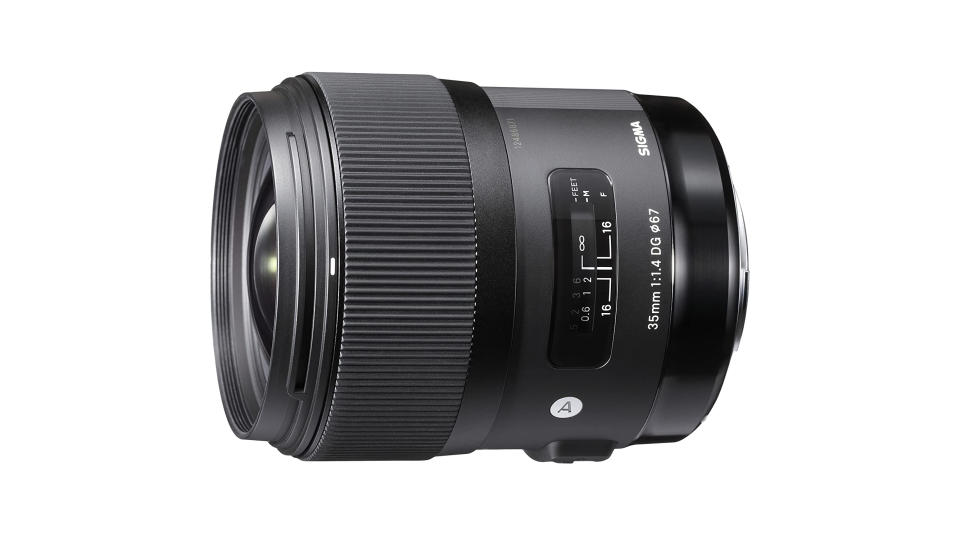
3. Sigma 35mm f/1.4 DG HSM | A
Relatively compact for a Sigma Art lens - it's a luxurious street lens
Mount: Canon EF | Elements/groups: 13/11 | Diaphragm blades: 9 | Autofocus: Ultrasonic (ring-type) | Stabilizer: No | Min focus distance: 0.3m | Max magnification: 0.19x | Filter thread: 67mm | Dimensions (WxL): 77x94mm | Weight: 665g
Sharp, with minimal fringing
Large max aperture
No stabilization or weather sealing
Heavy compared to Canon rivals
At 77x94mm and tipping the scales at 665g, this Sigma is smaller and lighter than the competing Samyang 35mm f/1.4 AS UMC AE manual-focus lens, although it’s still about twice that weight of Canon's EF and EF 35mm lenses.
Typical of Sigma’s Art prime lenses, it features a fast and whisper-quiet ring-type ultrasonic autofocus system, with the usual availability of manual override. For manual focusing, the reasonably generous rotational travel of the focus ring enables fine and precise adjustments. While the focus distance scale can be a bonus for manual focusing or setting the hyperfocal distance, depth of field markers are only applied for f/16, which makes zone focusing impractical.
The relatively complex and high-tech optical path includes two aspherical elements, one FLD (Fluorite-grade Low Dispersion) element, and four SLD (Special Low Dispersion) elements. Build quality is excellent throughout but the lens isn’t weather-sealed. In-camera corrections for lateral chromatic aberrations, peripheral illumination and distortion are available in most current and recent Canon DSLRs.
Image quality is pretty epic and the Sigma retains fabulous sharpness for an f/1.4 lens when shooting wide-open, right across the image frame. As you’d expect, things get even better when stopping down a little, and the lens is also a star performer in terms of minimizing color fringing and barrel distortion. It’s also very good value for such a high-tech, high-performance f/1.4 autofocus lens.
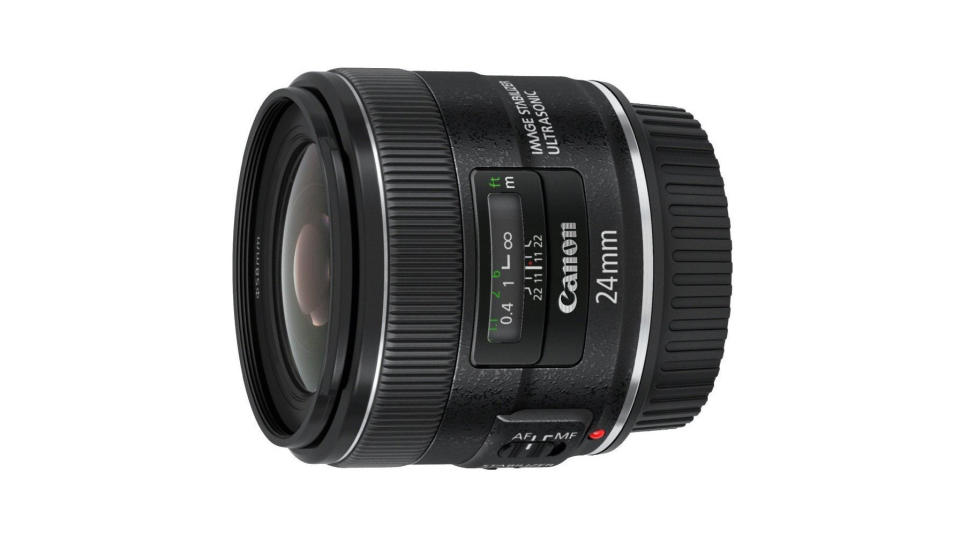
4. Canon EF 24mm f/2.8 IS USM
A full-frame lens, but it's ideal for street photography on an APS-C Canon DSLR
Mount: Canon EF | Elements/groups: 11/9 | Diaphragm blades: 7 | Autofocus: Ultrasonic (ring-type) | Stabilizer: Yes, 4-stop | Min focus distance: 0.2m | Max magnification: 0.23x | Filter thread: 58mm | Dimensions (WxL): 68x56mm | Weight: 280g
Highly-effective image stabilization
Excellent image quality
Small and light for a FF lens
Manual focusing can be tricky
When used with an APS-C camera, this 24mm f/2.8 for full-frame Canon DSLRs will give a focal length equivalent to 38.4mm It's a very small and lightweight lens with a more conventional 11 optical elements than the six found in the pancake version. The focus system is operated with a ring-type ultrasonic focus system rather than a stepping motor but that means it does have a focus distance scale - a feature lacking in most STM lenses - as well as depth of field markings at f/11 and f/22.
Image quality is very good delivering sharpness from corner to corner and when used on an APS-C body, the corners of the frame are cut off which also helps tp reduce distortion, color fringing and distortion.
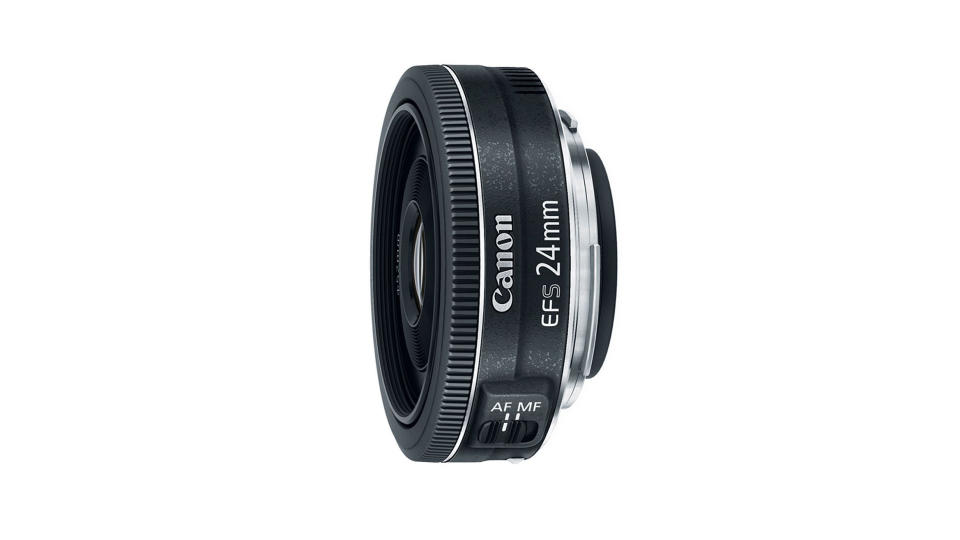
5. Canon EF-S 24mm f/2.8 STM
Street lenses for APS-C Canon DSLRs don't get more compact than this
Mount: Canon EF | Elements/groups: 6/5 | Diaphragm blades: 7 | Autofocus: Stepping motor | Stabilizer: No | Min focus distance: 0.16m | Max magnification: 0.27x | Filter thread: 52mm | Dimensions (WxL): 68x23mm | Weight: 125g
Excellent all-round image quality
Exceptionally small and light
Slightly narrow field of view
Not the fastest max aperture
This Canon lens for APS-C format DSLRs has a pancake design that enables a super-slim profile just 23mm deep. It's also a real lightweight at 125g - less than half the weight of Canon’s more conventional EF 24mm lens f/2.8 lens for full-frame DSLRs.
The six-element optical stack includes one aspherical element, Super Spectra coatings, and there's a fairly well-rounded seven-blade diaphragm. Autofocus is courtesy of a quick and quiet stepping motor, with an electronically coupled manual focus ring, though this is rather small and fiddly.
This 24mm optic has an ‘effective’ focal length of 38.4mm, which can feel a little narrow for street photography compared to a 35mm focal length. There’s also no image stabilizer, which can be more of a problem given the relatively slow f/2.8 max aperture.
Image quality is impressive with excellent sharpness across the frame and amazingly little color fringing, even without using in-camera corrections.
Nikon
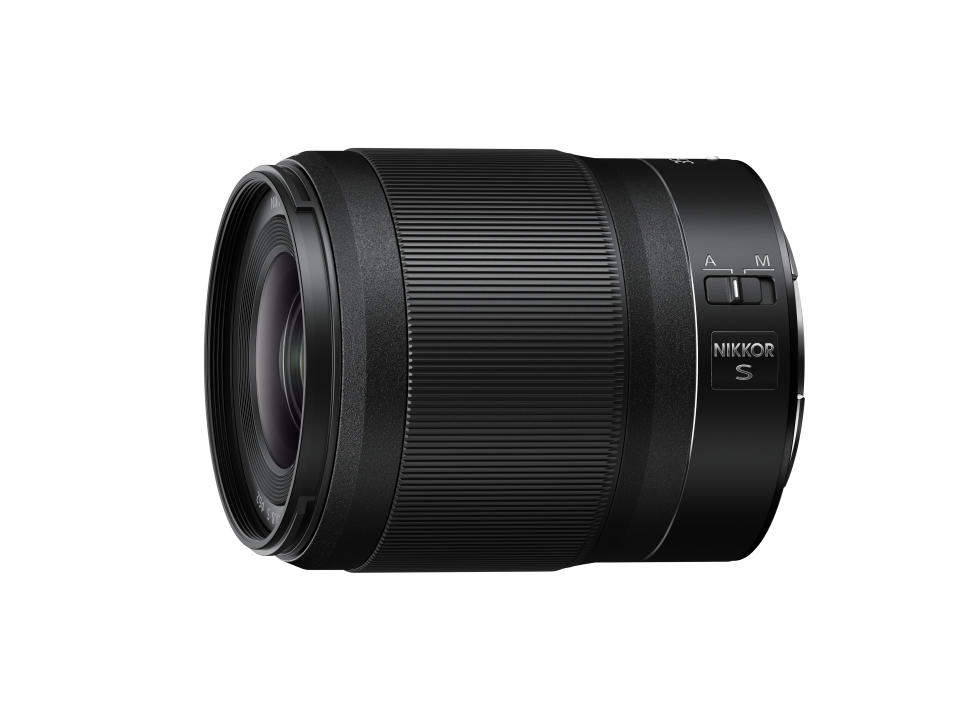
6. Nikon Z 35mm f/1.8 S
Nikon Z-camera owners come out on top, as this is a fabulous 35mm lens
Mount: Nikon Z | Elements/groups: 11/9 | Diaphragm blades: 9 | Autofocus: Stepping motor | Stabilizer: No | Min focus distance: 0.25m | Max magnification: 0.19x | Filter thread: 62mm | Dimensions (WxL): 73x86mm | Weight: 370g
Spectacular sharpness
Fast, silent AF
Precise manual focusing
Expensive for this type of lens
This Nikon Z-series lens is expensive for a 35mm street prime, despite it having a fairly modest f/1.8 aperture rating. However, it’s much more high-tech than Nikon’s F-mount AF-S 35mm f/1.8G ED, thanks to three aspherical elements and additional ED elements. It features both Super Integrated Coating and Nano Crystal Coat, for effectively minimizing ghosting and flare.
The stepping motor-based autofocus system is fast and virtually silent, while enabling very smooth and precise manual focusing via its electronically coupled control ring. When in autofocus mode, you can customize the function of the control ring. Typical of most stepping motor lenses, there’s no focus distance scale. However, directional focus assist lamps and a focus peaking option are available in Nikon Z 6 and Z 7 cameras.
Image quality is fabulous, with particularly stunning centre-sharpness. As with other Z-series lenses that we’ve tested, the relatively large-diameter mounting plate helps to enable superb image quality across the whole frame, while sharpness in handheld shooting is boosted by in-camera stabilization.
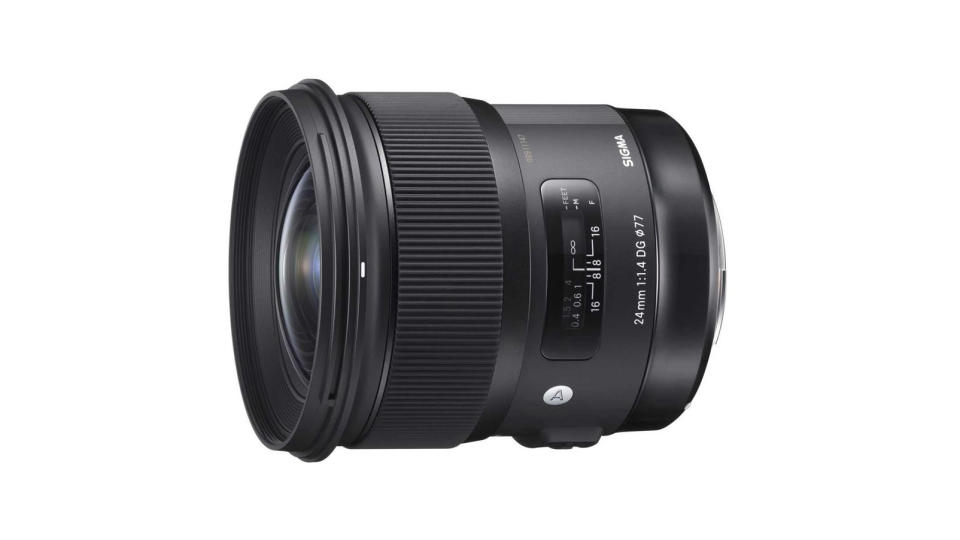
7. Sigma 24mm f/1.4 DG HSM | A
There’s no beating this lens for image quality on a Nikon DSLR
Mount: Nikon F, Canon EF, Sony E and Leica L | Elements/groups: 14/12 | Diaphragm blades: 9 | Autofocus: Ultrasonic (ring-type) | Stabilizer: No | Min focus distance: 0.85m | Max magnification: 0.12x | Filter thread: 86mm | Dimensions (WxL): 95x126mm | Weight: 1,130g
Superb all-round image quality
Fast, precise AF
On the heavy side
No weather seals
With a 24mm rather than 35mm focal length, this lens gives a wider viewing angle that can be useful for tight city streets. This lens packs a high-performance ring-type ultrasonic autofocus system, along with depth of field markers for f/8 and f/16. There are two aspherical and four SLD (Special Low Dispersion) elements, along with a trio of top-spec FLD (Fluorite-grade Low Dispersion) elements from one to three. The only thing missing is weather sealing.
Performance is excellent, with superb sharpness, even when shooting wide-open. The negligible levels of distortion and color fringing are even further reduced when using this 24mm as a street lens on a DX-format Nikon DSLR, where it gives a more traditional street photography focal length of 36mm.
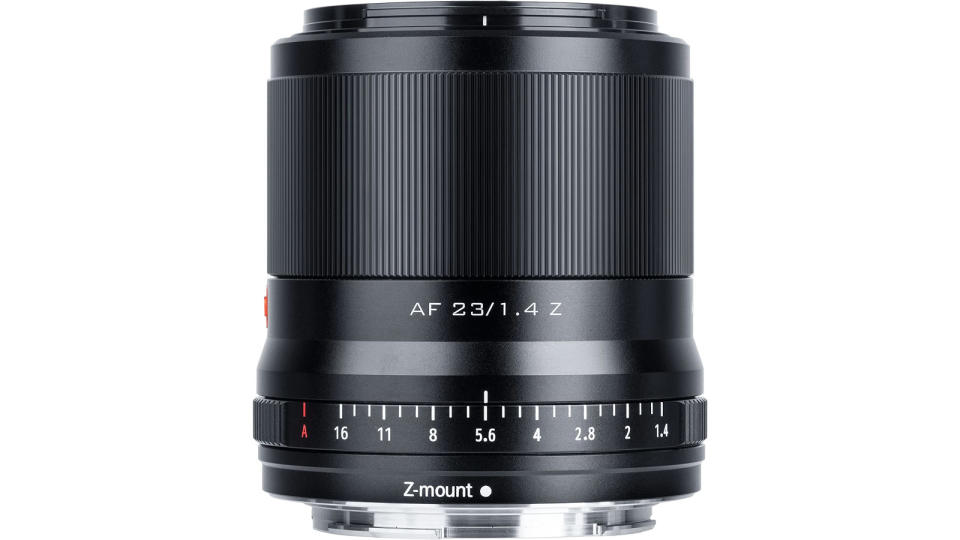
8. Viltrox AF 23mm F1.4 Z
A fast prime bulking out the APS-C options for Nikon Z
Mount: Nikon Z, Canon EF-M, Fujifilm X, Sony E | Elements/groups: 11/10 | Diaphragm blades: 9 | Autofocus: Stepping motor | Stabilizer: No | Min focus distance: 0.3m | Max magnification: 0.1x | Filter thread: 52mm | Dimensions (WxL): 69x73mm | Weight: 300g
Welcome aperture ring
Solidly built
No weather sealing
No aperture ring lock
Users of APS-C Nikon Z cameras like the Nikon Z50 and Nikon Z fc will find that there still aren't all that many natively APS-C lenses for this format, even from Nikon itself. Third-party manufacturers have eagerly stepped in to fill the breach, and the Viltrox AF 23mm F1.4 Z is an excellent choice for Z-mount users rocking a smaller sensor.
We tested this lens with the Nikon Z fc and it feels like an incredibly natural fit, suiting the camera's retro looks and tactile controls. Having an aperture ring gives the lens an immediate feel that's excellent for street photography, and the maximum aperture of f/1.4 means you've got flexibility when you need it.
We were generally impressed with the optical performance, and the all-metal build of the lens feels pleasingly premium. Ultimately though, this lens earns points simply by being something that Nikon isn't currently offering, and as such it's a great buy for APS-C Z-mount users.
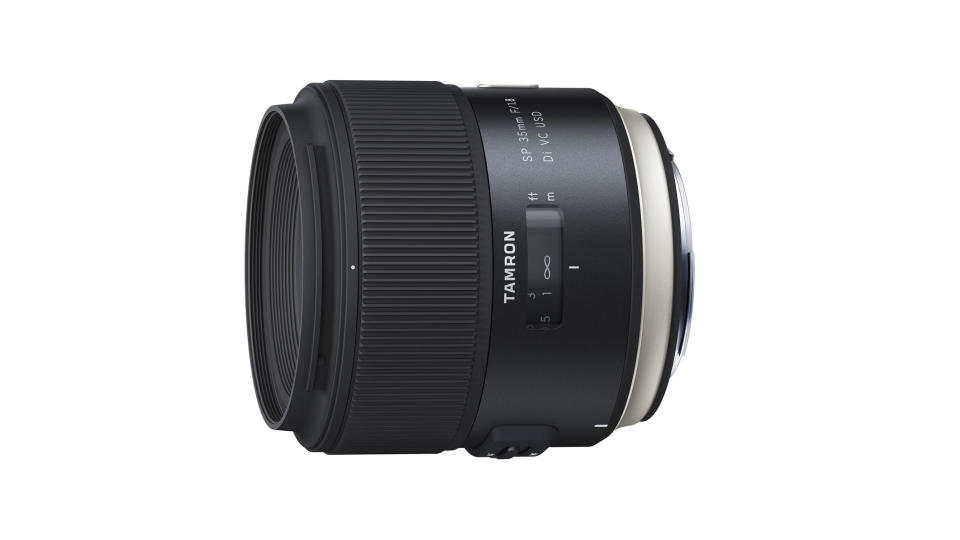
9. Tamron SP 35mm f/1.8 Di VC USD
Compact, tough, stabilized and weather-sealed - it's a value-packed street prime
Mount: Nikon F | Elements/groups: 10/9 | Diaphragm blades: 9 | Autofocus: Ultrasonic (ring-type) | Stabilizer: Yes | Min focus distance: 0.2m | Max magnification: 0.4x | Filter thread: 67mm | Dimensions (WxL): 80x81mm | Weight: 480g
0.2m close-focusing distance
Weather sealed
Centre-sharpness not great
Heavier than competing Nikon lens
While slightly slower than an f/1.4 street prime, the upside is that this f/1.8 Tamron is reasonably small and lightweight, although at 480g, it’s still rather weightier than a Nikon AF-S 35mm f/1.8G ED.
This Tamron is rare among F-mount street primes in that it features optical stabilization, with an effectiveness equivalent to about three f/stops, which can be a big bonus under dull lighting. Rain needn’t stop play either, as the lens has extensive weather-seals and a fluorine coating on its front element. It focuses closer than average, right down to 0.2m, where it delivers a generous 0.4x maximum magnification factor.
Autofocus and manual focus both work very well, although the focus distance scale lacks any depth of field markings, putting zone focusing off-limits. Image quality is very good overall but, for outright sharpness, the Tamron isn't quite class-leading. Fringing is also a bit more noticeable than from most competing lenses.

10. Sigma 35mm f/1.4 DG HSM | A
A large, heavy lens, but it's also big on build quality and performance
Mount: Nikon F | Elements/groups: 13/11 | Diaphragm blades: 9 | Autofocus: Ultrasonic (ring-type) | Stabilizer: No | Min focus distance: 0.3m | Max magnification: 0.19x | Filter thread: 67mm | Dimensions (WxL): 77x94mm | Weight: 665g
Stunning image quality
Gorgeous build
Heavy and bulky
Impractical zone focusing
This Sigma is about twice the weight of Nikon's AF-S 35mm f/1.8G ED lens, but you do get excellent build quality throughout, although it's a pity the lens isn’t weather-sealed. Typical of Sigma’s Art primes, it features a fast and whisper-quiet ring-type ultrasonic autofocus system. For manual focusing, the reasonably generous rotational travel of the focus ring enables fine and precise adjustments, although depth of field markers are only available for f/16, which makes zone focusing impractical.
The high-tech optical path includes two aspherical elements, one FLD (Fluorite-grade Low Dispersion) element, and four SLD (Special Low Dispersion) elements. They help produce epic Image quality, as the Sigma retains fabulous sharpness for an f/1.4 lens when shooting wide-open, right across the image frame. As you’d expect, things get even better when stopping down a little, and the lens is also a star performer in terms of minimizing color fringing and barrel distortion. It’s also very good value for such a high-performance f/1.4 autofocus lens.
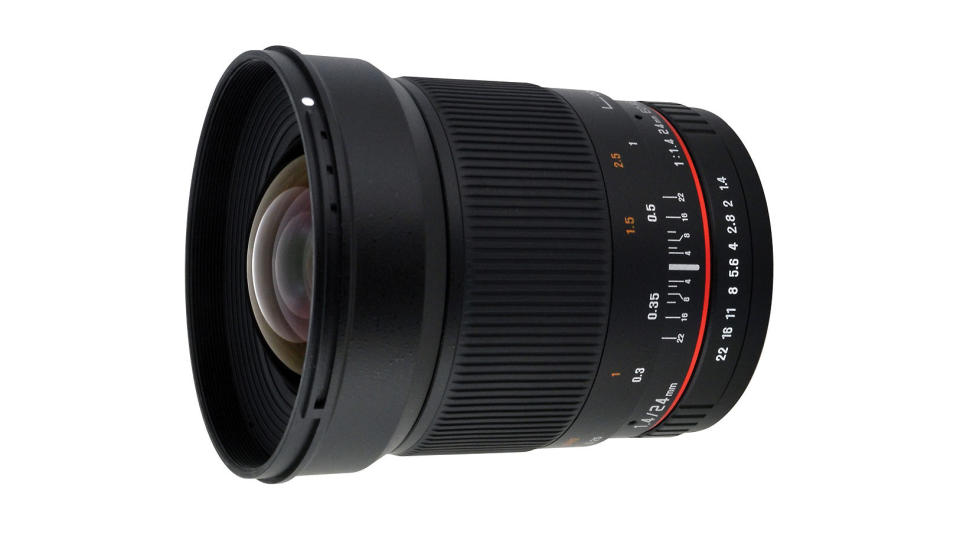
11. Samyang 24mm f/1.4 ED AS IF UMC
An affordable manual-focus lens ideal for street photography on Nikon DX bodies - a rare thing indeed
Mount: Nikon F | Elements/groups: 13/12 | Diaphragm blades: 8 | Autofocus: N/A | Stabilizer: No | Min focus distance: 0.25m | Max magnification: unspecified | Filter thread: 77mm | Dimensions (WxL): 83x95mm | Weight: 565g
Great for DX Nikon bodies
Tactile manual focus
Manual focus only
Fringing noticeable on FF body
Although it’s full-frame compatible, this 24mm has an ‘effective’ focal length of 36mm when used on a DX format body, ideal for street photography. Though manual focus only, this Nikon F-mount edition has electronics to enable PASM shooting with camera-driven aperture control, plus illumination of focus-assist/confirmation lamps in the viewfinder.
A little smaller and lighter than Samyang's 35mm f/1.4 AS UMC AE lens, the 24mm nevertheless has an additional optical element, taking the total count to 13. Whereas the 35mm has a glass aspherical element and two HR (High Refractive index) elements, the 24mm doubles up on aspherical elements and features four ED (Extra-low Dispersion) elements. Both have Samyang’s Ultra Multi Coating to reduce ghosting and flare.
The long-travel focus ring enables smooth and precise adjustments, with depth of field markers for f/4, f/8, f/16 and f/22 on the focus distance scale. Centre-sharpness is disappointing wide-open but excellent when stopping down a little, however fringing is worse than average at the corners of the frame. But this is conveniently cropped out when the lens is used on a DX Nikon body.
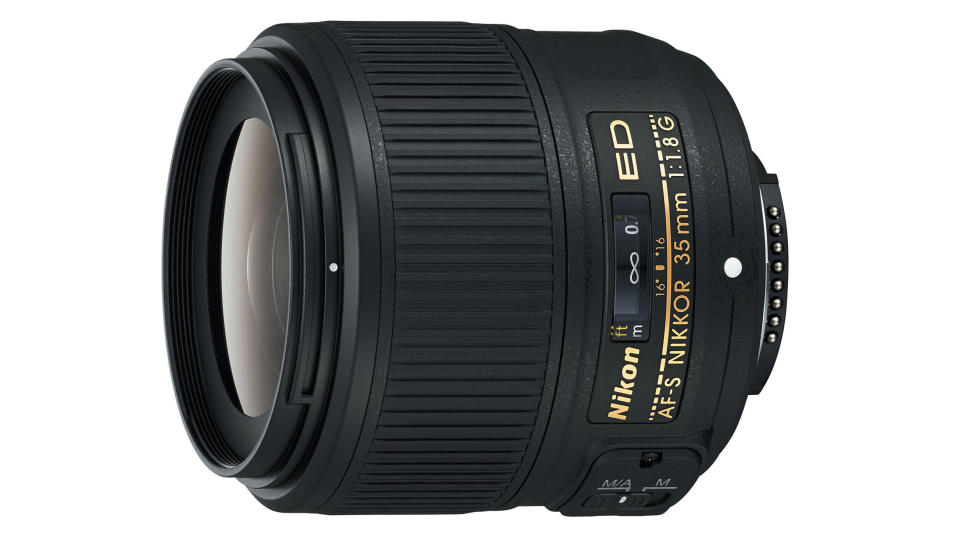
12. Nikon AF-S 35mm f/1.8G ED
A good - but not great - all-rounder, but it is small and light
Mount: Nikon F | Elements/groups: 11/8 | Diaphragm blades: 7 | Autofocus: Ultrasonic (ring-type) | Stabilizer: No | Min focus distance: 0.25m | Max magnification: 0.24x | Filter thread: 58mm | Dimensions (WxL): 72x72mm | Weight: 305g
Very compact
Good sharpness
Basic 7-blade diaphragm
Noticeable falloff at f/1.8
Compared with Nikon’s new Z series 35mm for its mirrorless cameras, this F-mount lens is smaller, lighter and much less expensive. Both lenses have the same f/1.8 aperture rating.
The ring-type ultrasonic system is typically quick and quiet, as well as enabling full-time manual override. There’s a focus distance scale but it’s of limited benefit for manual focusing, as there are no markings between 0.7m an infinity, and only rudimentary depth of field markers for f/16. Optical highlights include one aspherical element, one ED (Extra-low Dispersion) element and Super Integrated Coating.
Bearing in mind that this lens is less than half the weight of the competing Sigma 35mm f/1.4 DG HSM | A, it packs plenty of punch. Sharpness is mostly very good, contrast is excellent even when shooting wide-open, and there’s pretty good resistance to ghosting and flare. However, the seven-blade diaphragm isn’t particularly well-rounded and vignetting is very noticeable when shooting wide-open.
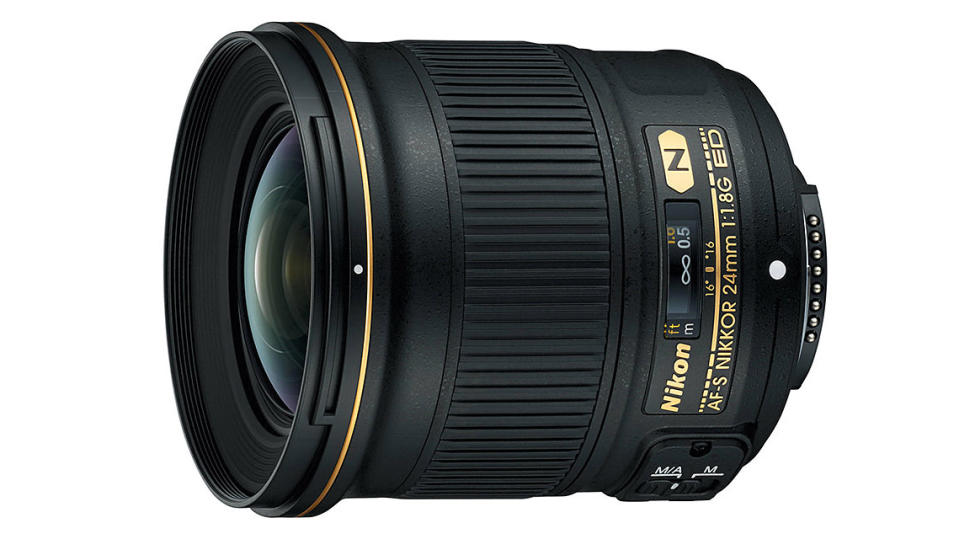
13. Nikon AF-S 24mm f/1.8G ED
Not a bad street prime, but rivals offer more for less money
Mount: Nikon F | Elements/groups: 12/9 | Diaphragm blades: 7 | Autofocus: Ultrasonic (ring-type) | Stabilizer: No | Min focus distance: 0.23m | Max magnification: 0.2x | Filter thread: 72mm | Dimensions (WxL): 78x83mm | Weight: 355g
Small and light
Good autofocusing
Sharpness not great
No stabilization
This Nikon is full-frame compatible but gives a virtually identical viewing angle to a 35mm lens, when mounted on a DX format body. Its f/1.8 max aperture makes the lens noticeably smaller and more lightweight than an f/1.4, which is a bonus for street photography. Build quality doesn’t feel particularly solid, but at least the lens features a weather-seal on its mounting plate.
Compared with the Nikon AF-S 35mm f/1.8G ED, this 24mm has a similar optical layout with one aspherical element and one ED element. Again, there’s a seven-blade diaphragm but the 24mm lens gains Nano Crystal Coat for better reduction of ghosting and flare.
Performance and image quality are very good, but edge/corner sharpness isn’t as impressive as from the Sigma 24mm f/1.4 DG HSM | A. The Nikon also lacks the competing Tamron SP 35mm f/1.8 Di VC USD's stabilization. All things considered, it’s not great value for money.
Sony
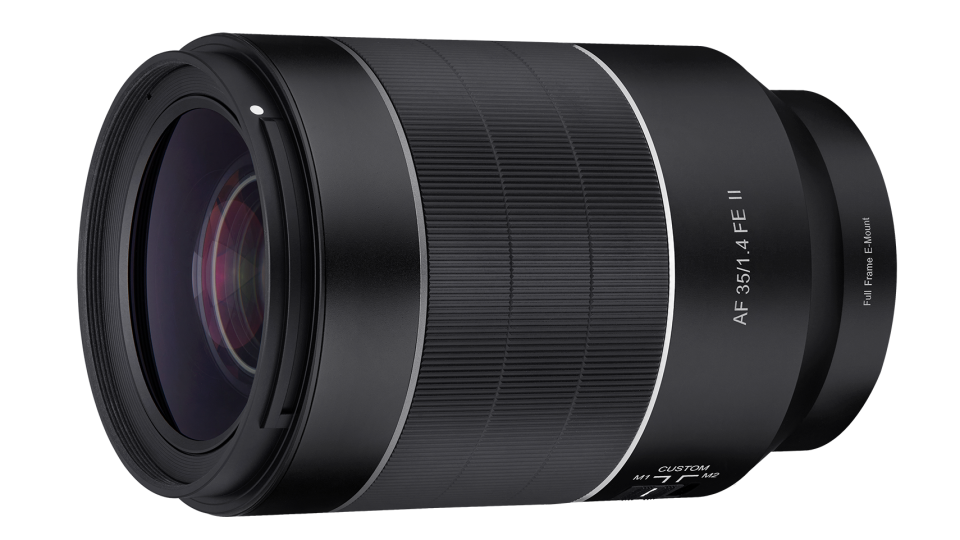
14. Samyang AF 35mm F1.4 FE II
This alternative to the G Master lens comes at half the price
Mount: Sony E | Elements/groups: 11/9 | Diaphragm blades: 9 | Autofocus: Linear stepping motor | Stabilizer: No | Min focus distance: 0.29m | Max magnification: 0.18x | Filter thread: 67mm | Dimensions (WxL): 75x115mm | Weight: 659g
Outstanding value for money
Great handling/controls
Big and heavy for 35mm
Some distortion
While Sony's G Master lenses are some of the finest optics around, they come at a premium price that not everyone is up for paying. For a budget alternative, consider the Samyang AF 35mm F1.4 FE II, a third-party lens that delivers generally excellent optical performance for about half the price of its GM equivalent.
With a wide f/1.4 aperture, this lens is ideal for street work at all times of day. In our review we appreciated many of the extra features that have been added to this Mark II version, such as the two-way Custom switch that allows you to use the focus control ring for manual override of autofocus or for stepless aperture control. it's the touches like this that make the Samyang AF 35mm F1.4 FE II such an enjoyable lens to handle, even if it is quite a bit bigger and heavier than more expensive versions.
Optical performance is excellent too, making this an all-around highly credible choice of street lens for full-frame Sony users.
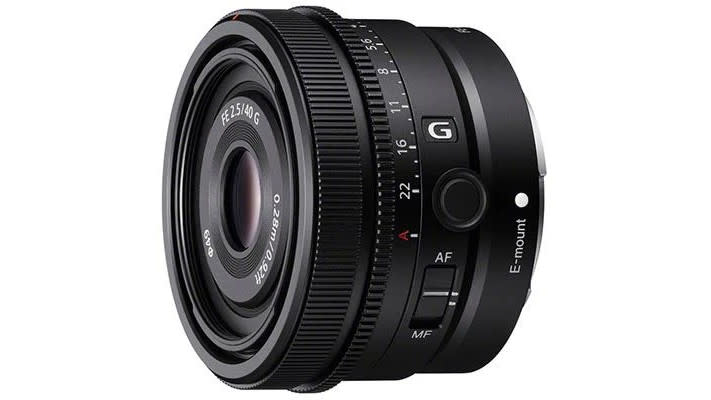
15. Sony FE 40mm f2.5 G Lens
This G Master optic is Sony's finest walk-around lens
Mount: Sony E | Elements/groups: 9/9 | Diaphragm blades: 7 | Autofocus: Double linear motors | Stabilizer: No | Min focus distance: 0.28m | Max magnification: 0.2x | Filter thread: 49mm | Dimensions (WxL): 68x45mm | Weight: 173g
Superb quality
Small, light, well-balanced
AF fast and silent
No focus distance scale
A lot of Sony's premium zoom lenses are really rather big and heavy. For photographers who are getting sick of carting this hefty optics around, the firm has started producing a series of small, lightweight primes, and this one might be the most useful of them all. The Sony FE 40mm f/2.5 G bears a focal length a shade below "standard", which is extremely useful for street photography. It's a G Master lens, and optically it's pretty much faultless, with incredible sharpness throughout the aperture range, across the frame.
This lightweight lens is perfect to attach to your Sony camera and just walk around with for hours. The balance and feel is so much better than it is with the hefty zooms, and the autofocus is fast and accurate enough to catch pretty much anything. Sony has done a really impressive job here, and any Alpha-using street photographer should definitely make this lens a primary consideration.
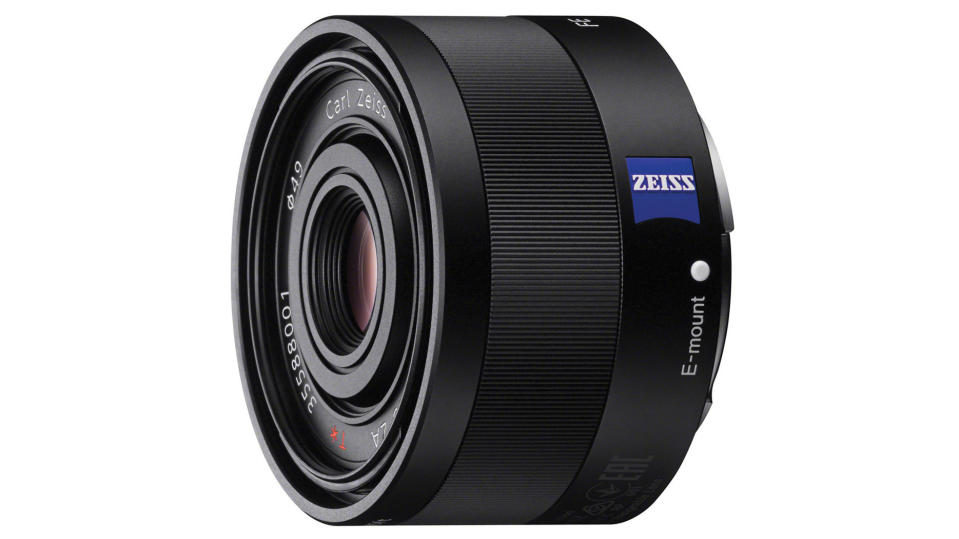
16. Sony FE 35mm f/2.8 ZA Carl Zeiss Sonnar T*
It's not quite the sharpest, but portability makes this lens a winner for Sony shooters
Mount: Sony E | Elements/groups: 7/5 | Diaphragm blades: 7 | Autofocus: Stepping motor | Stabilizer: No | Min focus distance: 0.35m | Max magnification: 0.12x | Filter thread: 49mm | Dimensions (WxL): 62x37mm | Weight: 120g
Super small and ultra light
Decent image quality
Not cheap
Sharpness could be higher
With diminutive dimensions of 62x37mm, this Sony doesn’t quite qualify as a pancake lens but it’s just as ultra-portable and convenient, plus it weighs a mere 120g. It therefore forms part of a very discreet package when mounted on an A7 or A9 series body. Downsizing is enabled by the inclusion of three aspherical elements in the Zeiss Sonnar design, along with a modest f/2.8 aperture rating. The lens also features legendary T* coatings.
Autofocus is based on a fast and quiet linear motor, with an electronically coupled focus ring that gives the option of manual override, via in-camera menus. Typical of this arrangement, there’s no focus distance scale nor depth of field markers, but focus assist and peaking facilities are available in-camera.
The tiny Sony punches above its weight in terms of image quality, although vignetting is quite severe at f/2.8. Sharpness is very impressive in the central region of the frame, less so towards the edges. Distortion is of a fairly low order, but it’s not entirely uniform and is tricky to correct.
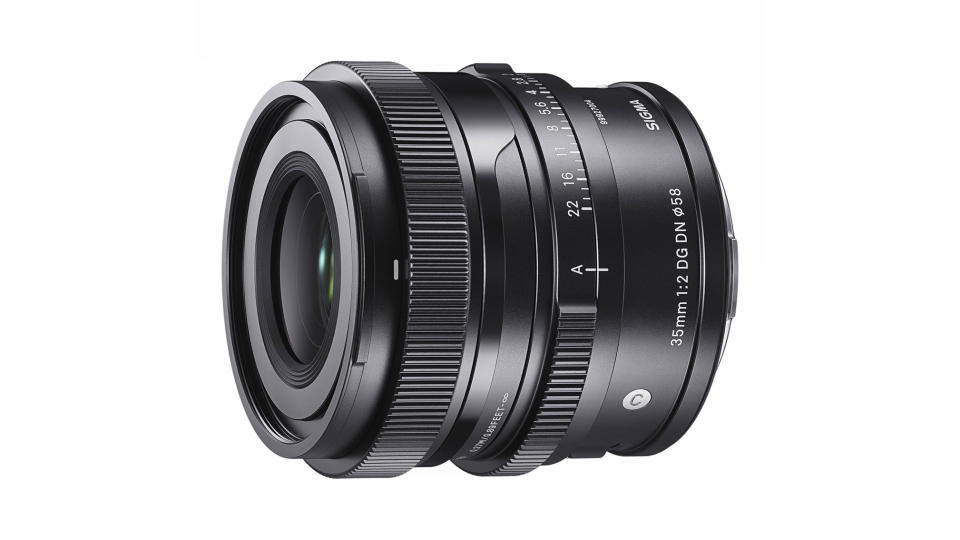
17. Sigma 35mm f/2 DG DN Contemporary
A small lens that’s big on quality
Mount: Sony E, Leica L | Elements/groups: 10/9 | Diaphragm blades: 9 | Autofocus: Linear-motor | Stabilizer: No | Min focus distance: 0.27m | Max magnification: 018x | Filter thread: 58mm | Dimensions (WxL): 70x65mm
High quality metal construction
Good handling characteristics
f/2 isn’t overly fast
No focus distance scale
Sigma's spoilt us with large and fast 35mm prime lenses recently, including the excellent 35mm f/1.4 DG HSM Art and the monster 35mm f/1.2 DG DN Art lenses. The new Sigma 35mm f/2 DG DN Contemporary, as the name suggests, is part of the company's ‘Contemporary’ line-up and sports a more compact and lightweight build. Weighing in at a just 325g, it still features a full metal casing (and there's also a nice metal lens hood as well), while the aperture ring offers a very tactile alternative for shooting in manual and aperture-priority modes. Focusing is fast and virtually silent, while sharpness is very good across the whole frame when shooting wide-open. The f/2 maximum aperture might not be quite as impressive as faster lenses, but this is a great little lens for everyday shooting.

18. Sigma 35mm f/1.4 DG HSM | A
A fabulous lens for Sony E and A-mount cameras, if not the most portable
Mount: Sony E | Elements/groups: 13/11 | Diaphragm blades: 9 | Autofocus: Ultrasonic (ring-type) | Stabilizer: No | Min focus distance: 0.3m | Max magnification: 0.19x | Filter thread: 67mm | Dimensions (WxL): 77x94mm | Weight: 665g
Great image quality, even wide open
Outstanding build
Top-notch AF
Relatively large and heavy
Compared to Sony's featherweight 35mm f/2.8 ZA prime, this Sigma is over five times the weight and almost three times as long. Typical of Sigma’s Art primes, it features a fast and whisper-quiet ring-type ultrasonic autofocus system. For manual focusing, the reasonably generous rotational travel of the focus ring enables fine and precise adjustments, although depth of field markers are only available for f/16 - not much good for zone focusing.
The high-tech optical path includes two aspherical elements, one FLD (Fluorite-grade Low Dispersion) element, and four SLD (Special Low Dispersion) elements. Build quality is excellent throughout, although the lens isn’t weather-sealed.
Image quality is superb, as the Sigma retains fabulous sharpness for an f/1.4 lens when shooting wide-open, right across the image frame. As you’d expect, things get even better when stopping down a little, and the lens is also a star performer in terms of minimizing color fringing and barrel distortion. It’s also very good value for such a high-performance f/1.4 autofocus lens.
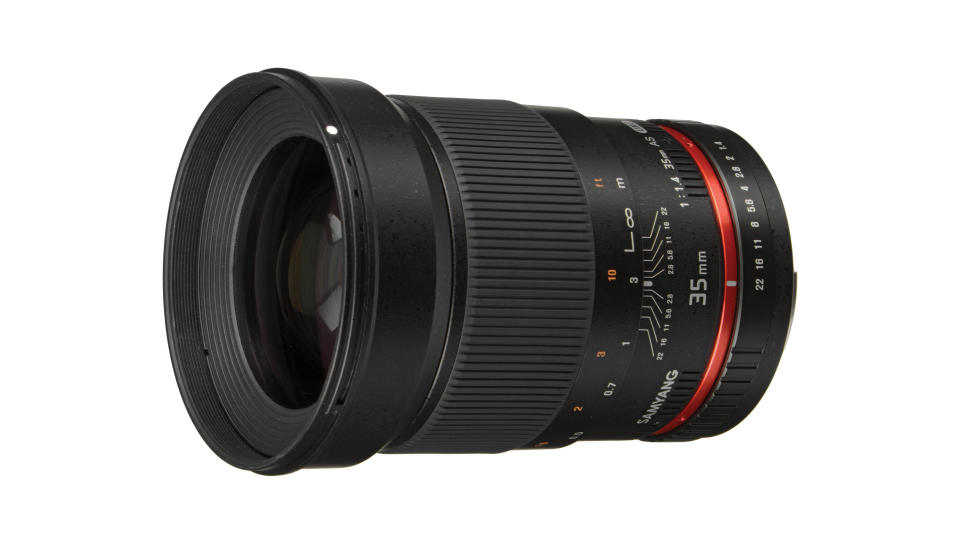
19. Samyang 35mm f/1.4 AS UMC
Top option for traditional, manual focus street photography with your Sony
Mount: Sony E | Elements/groups: 12/10 | Diaphragm blades: 8 | Autofocus: N/A | Stabilizer: No | Min focus distance: 0.3m | Max magnification: unspecified | Filter thread: 77mm | Dimensions (WxL): 83x110mm
Good manual & zone focusing
Competitively priced
Not the sharpest at f/1.4
Big and relatively heavy
Sold under the Rokinon brand in the States, this Samyang prime lenses comes in a variety of lens mount options. The Canon and Nikon-fit versions get electronics to communicate with the camera body, however the Sony E-mount edition is much more basic, meaning you can only adjust aperture using the lens's own aperture ring.
The focus ring has plenty of rotational travel and it's precise in operation. Zone focusing is enabled by the focus distance scale and depth of field markers for apertures of f/2.8, f/5.6, f/11, f/16 and f/22. This is a real bonus for traditional street photography, where you set the focus distance ahead of shooting.
As an f/1.4 lens, the Samyang is comparatively big and heavy, but sharpness and contrast are disappointing at apertures wider than f/2. Stop down to f/2.8 and image quality becomes excellent in all respects.
If you want to get back to basics and shoot fully manual out on the street, this is the lens for the job.

20. Sony FE 35mm f/1.8
It's not perfect, but this is one of Sony's most versatile prime lenses
Mount: Sony E | Elements/groups: 11/9 | Diaphragm blades: 9 | Autofocus: Linear-motor | Stabilizer: No | Min focus distance: 0.22m | Max magnification: 0.24x | Filter thread: 55mm | Dimensions (WxL): 65x73mm
Very sharp wide open
Fast focusing
Well-made and balances nicely
Limited weather-sealing
Until recently, Sony users had to choose between the Zeiss Distagon FE 35mm f/1.4 ZA – an expensive, premium lens – and the older Zeiss 35mm f/2.8 (see above) if they wanted a 35mm perspective on an E-mount camera. The arrival of the FE 35mm f/1.8 sees it fit nicely between the two and offers a great blend of performance, value and handling.
In our review, we mention that the lens balances nicely on Alpha A7 series cameras, while the build quality is overall very good. It's a shame that there's no weather-sealing, but that does help keep the price down and that's soon forgotten when you start shooting with it. Focusing is very fast, while the lens is very sharp wide open. Bokeh is nicely rendered as well, producing smooth defocused areas in the image.
This is a great lens for Alpha A7 and A9 users looking for a compact and sharp prime but don't want to break the bank with one of Sony's G Master optics.
How we test lenses
We test lenses using both real world sample images and lab tests. Our lab tests are carried out scientifically in controlled conditions using the Imatest testing suite, which consists of custom charts and analysis software that measures resolution in line widths/picture height, a measurement widely used in lens and camera testing. We find the combination of lab and real-word testing works best, as each reveals different qualities and characteristics. See more on how we test and review at Digital Camera World.
Read more:
The best camera for street photography
The best books on street photography
Shoot street photography like a pro Part 1 Part 2 Part 3 Part 4
The best camera bag for travel
The best travel tripods